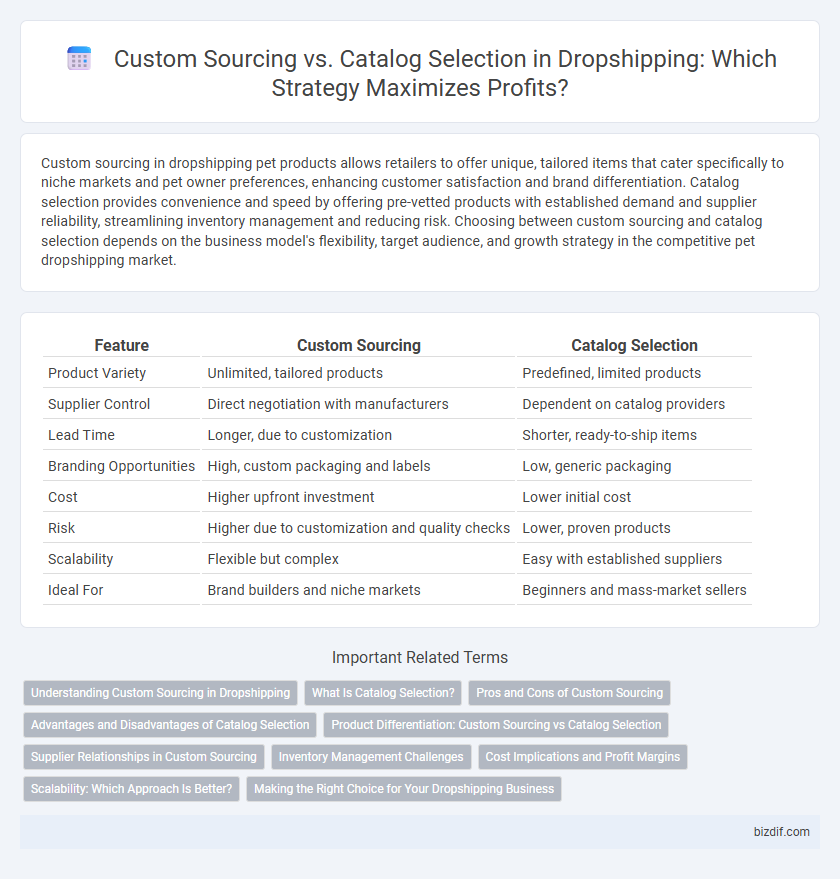Custom sourcing in dropshipping pet products allows retailers to offer unique, tailored items that cater specifically to niche markets and pet owner preferences, enhancing customer satisfaction and brand differentiation. Catalog selection provides convenience and speed by offering pre-vetted products with established demand and supplier reliability, streamlining inventory management and reducing risk. Choosing between custom sourcing and catalog selection depends on the business model's flexibility, target audience, and growth strategy in the competitive pet dropshipping market.
Table of Comparison
| Feature | Custom Sourcing | Catalog Selection |
|---|---|---|
| Product Variety | Unlimited, tailored products | Predefined, limited products |
| Supplier Control | Direct negotiation with manufacturers | Dependent on catalog providers |
| Lead Time | Longer, due to customization | Shorter, ready-to-ship items |
| Branding Opportunities | High, custom packaging and labels | Low, generic packaging |
| Cost | Higher upfront investment | Lower initial cost |
| Risk | Higher due to customization and quality checks | Lower, proven products |
| Scalability | Flexible but complex | Easy with established suppliers |
| Ideal For | Brand builders and niche markets | Beginners and mass-market sellers |
Understanding Custom Sourcing in Dropshipping
Custom sourcing in dropshipping involves partnering directly with manufacturers or suppliers to create unique or branded products tailored to specific market needs. This approach allows sellers to differentiate their store offerings, improve profit margins, and build stronger customer loyalty by providing exclusive items not found in standard catalogs. Leveraging custom sourcing requires effective communication, quality control, and a deep understanding of market trends to ensure product relevance and timely fulfillment.
What Is Catalog Selection?
Catalog selection in dropshipping refers to choosing products from a pre-existing list offered by suppliers, enabling faster store setup and easier inventory management. This method limits customization but provides access to trending, high-demand items already vetted for quality and supplier reliability. It streamlines order fulfillment by syncing with supplier catalogs, reducing the need for extensive product research or direct supplier negotiations.
Pros and Cons of Custom Sourcing
Custom sourcing in dropshipping offers the advantage of unique product selection, allowing businesses to differentiate themselves with exclusive items tailored to niche markets, which can boost brand identity and customer loyalty. However, it often involves longer lead times and higher upfront costs due to the need for supplier negotiation and sample validation, posing risks for cash flow and inventory management. This approach demands strong supplier relationships and quality control to mitigate the challenges of inconsistent product availability and shipment delays common in custom orders.
Advantages and Disadvantages of Catalog Selection
Catalog selection in dropshipping offers the advantage of convenience by providing pre-curated products, enabling faster store setup and easier inventory management. This approach minimizes the risk of product sourcing errors but limits customization and differentiation from competitors who use similar catalogs. Dependence on supplier catalog accuracy and potential inventory fluctuations can impact customer satisfaction and order fulfillment reliability.
Product Differentiation: Custom Sourcing vs Catalog Selection
Custom sourcing in dropshipping enables businesses to create unique products tailored to specific customer needs, enhancing brand identity and competitive advantage. Catalog selection relies on already existing products, offering limited differentiation but faster market entry and reduced costs. Leveraging custom sourcing allows for innovation and exclusive offerings, while catalog selection prioritizes convenience and extensive product variety.
Supplier Relationships in Custom Sourcing
Custom sourcing in dropshipping fosters stronger supplier relationships by facilitating direct communication and collaboration, leading to tailored product offerings and improved quality control. This approach enhances trust and reliability, allowing merchants to negotiate better terms and respond swiftly to market demands. Supplier partnerships developed through custom sourcing often result in exclusive products that differentiate the store from competitors relying solely on catalog selection.
Inventory Management Challenges
Custom sourcing in dropshipping allows tailored product selection but often complicates inventory management due to unpredictable supplier stock levels and longer restocking times. Catalog selection offers streamlined inventory control with pre-defined product lists, reducing the risks of stockouts and overselling. Effective inventory synchronization tools are essential to mitigate mismatches between supplier availability and customer orders in both approaches.
Cost Implications and Profit Margins
Custom sourcing in dropshipping often involves higher upfront costs due to tailored product development and exclusive supplier agreements, which can reduce profit margins initially but may allow for premium pricing and brand differentiation over time. Catalog selection typically offers lower startup expenses and quicker access to a wide range of products, enabling faster inventory turnover and more consistent profit margins. Choosing between custom sourcing and catalog selection depends on balancing cost implications with desired profitability and long-term business strategy.
Scalability: Which Approach Is Better?
Custom sourcing offers greater scalability by allowing dropshippers to tailor products to market trends and customer preferences, enabling unique offerings that reduce direct competition. Catalog selection provides faster scalability initially due to pre-existing product availability and established supplier relationships, but may limit long-term growth due to less flexibility and higher risk of saturation. For sustainable scalability in dropshipping, custom sourcing is often more advantageous as it supports niche targeting and brand differentiation.
Making the Right Choice for Your Dropshipping Business
Custom sourcing in dropshipping allows entrepreneurs to tailor products to niche markets, enhancing brand uniqueness and customer loyalty, while catalog selection offers quicker product availability and reduced upfront costs by leveraging existing suppliers' inventories. Evaluating factors such as market demand, supplier reliability, product quality, and shipping times is essential for making the right choice. Prioritizing scalability and customer experience will determine whether a customized approach or a curated catalog best supports sustainable growth in your dropshipping business.
Custom Sourcing vs Catalog Selection Infographic

 bizdif.com
bizdif.com